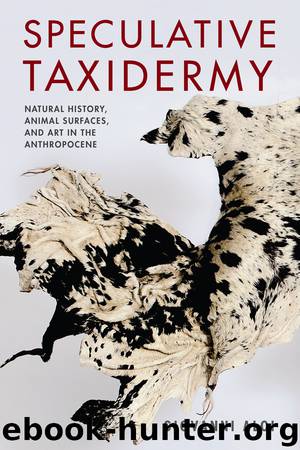Speculative Taxidermy by Giovanni Aloi

Author:Giovanni Aloi
Language: eng
Format: epub
Publisher: Columbia University Press
FIGURE 5.1 Meret Oppenheim, Object, 1936, Paris. Fur-covered cup, saucer, and spoon. The Museum of Modern Art, New York. © ARS, New York.
Careful consultation of surrealists’ texts reveals, for instance, that Breton3 and other artists were concerned with an early form of flat ontology in which objects, similarly to those in Graham Harman’s object-oriented ontology, existed in two dimensions: the “material realm,” the essence of the object or the impenetrable essence that characterizes it, and the sensual realm, the numerous qualities that an object displays in relation to other objects.4 This condition will be further explored in chapter 6, but for the time being, it is important to note that the Freudian notion of the uncanny entails a rather similar structure. The uncanny object is simultaneously materially present and epistemologically withdrawn, yet it is also in constant relation to other objects. By establishing this fluidity, Harman hopes to instill an ontological instability by which all objects are made uncanny, not in the sense that they quiver in symbolic allusions, but that they remain inaccessible beyond the sensuality that other objects cast upon them—“the mist of accidental features and profile” that material presence cannot escape. Our apprehension of the object is therefore always relegated to the surface level: even when we cut into an apple or an animal body, our action is only capable of multiplying surfaces: the essence of the object relentlessly withdraws. Our impossibility to ascertain the essence of objects situates all experienceable surfaces as veneers, thin layers of materiality inscribed with information but simultaneously unable to make deeper claims about the essence of the objects they conceal.
As a surrealist piece and in consideration of its emphasis on surface aesthetics, Oppenheim’s Object can be simply understood as leveraging this very notion of phenomenological essentialism—one that is sufficient to grant the piece an agential force it would not possess without its fur coating. Trained by the long-lasting legacy of classical art, the western art historical gaze, far too quickly, defaults on the anthropocentric games played upon the symbolic register. In this game, the hermeneutical key is always at hand.
The material register of surrealist objects, the grounds upon which the semantic instability of the object unravels, has been substantially underscrutinized. Leveraging the materiality, or remaining closer to it, prevents interpretation from “leaving the object behind” in the production of pure symbols. The erotic allusions inscribed in Object have always been given precedence over anything else the art piece might be capable of doing. Its uncanny thingness is thus castrated and domesticated with every seemingly successful symbolic reading that the art historical gaze stitches onto it. But what could be gained in refraining from the symbolic leap? And how can the surrealist object be understood as a glimpse of a broader crisis of materiality that will become exacerbated in the current stage of the Anthropocene?
There exists an ethical and political dimension to the readymade work of art that can only be teased out from its materiality and by following its materiality through sociocultural transactions and inscriptions that are specific and interlinked.
Download
This site does not store any files on its server. We only index and link to content provided by other sites. Please contact the content providers to delete copyright contents if any and email us, we'll remove relevant links or contents immediately.
Enlightenment Now: The Case for Reason, Science, Humanism, and Progress by Steven Pinker(7235)
A Journey Through Charms and Defence Against the Dark Arts (Harry Potter: A Journey Through…) by Pottermore Publishing(4781)
The Immortal Life of Henrietta Lacks by Rebecca Skloot(4525)
A Journey Through Divination and Astronomy by Publishing Pottermore(4344)
Elon Musk by Ashlee Vance(4030)
Origin Story: A Big History of Everything by David Christian(3648)
COSMOS by Carl Sagan(3554)
Alchemy and Alchemists by C. J. S. Thompson(3451)
Bad Pharma by Ben Goldacre(3356)
Enlightenment Now by Steven Pinker(3338)
Shadow of Night by Deborah Harkness(3302)
Inferior by Angela Saini(3276)
A Mind For Numbers: How to Excel at Math and Science (Even If You Flunked Algebra) by Barbara Oakley(3220)
Origin Story by David Christian(3147)
The Code Book by Simon Singh(3074)
Signature in the Cell: DNA and the Evidence for Intelligent Design by Stephen C. Meyer(3071)
The Elements by Theodore Gray(2998)
A Brief History of Time by Stephen Hawking(2961)
A Journey Through Potions and Herbology (A Journey Through…) by Pottermore Publishing(2828)
